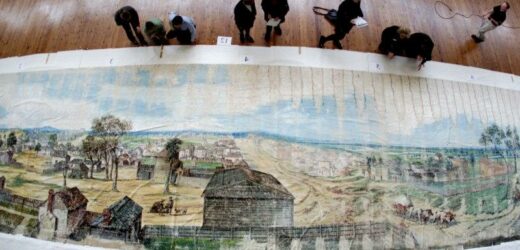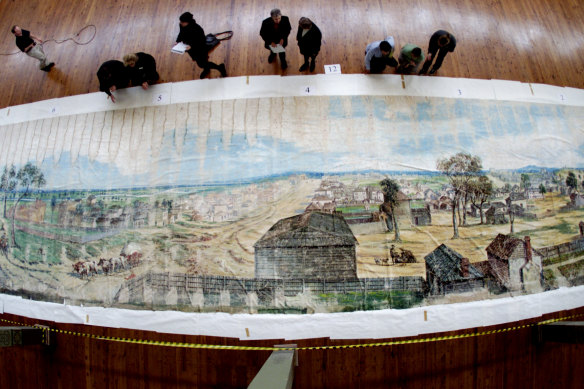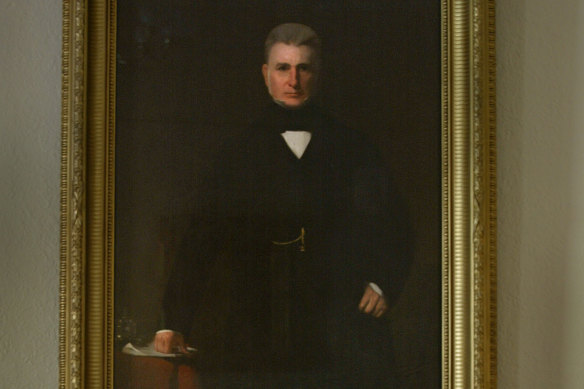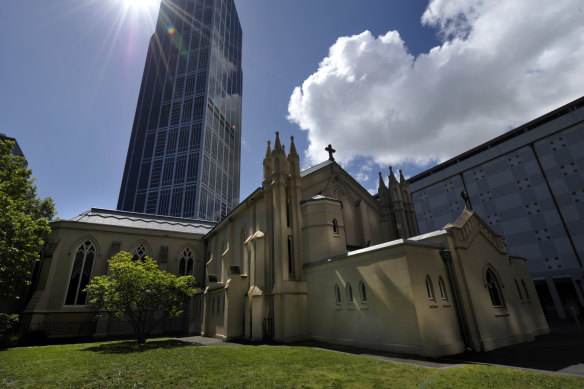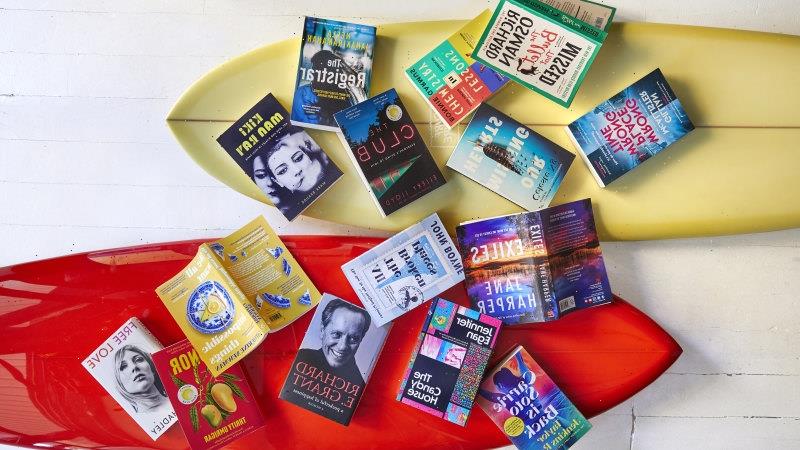In a small pub on Collins Street, 180 years ago this week, the City of Melbourne had its first meeting.
The first vote to elect 12 councillors was held on December 1, 1842 and according to colonial journalist “Garyowen” it was a wildly exciting and keenly contested affair. A week later the new councillors elected brewery owner Henry Condell as the first mayor. On December 15, the first council meeting was held at the Royal Hotel, which stood near the corner of Collins and Queen Streets.
A 30-metre cyclorama painting showing a 360 degree view of Melbourne in the 1840s, which was unrolled in 2000 at the Melbourne Exhibition Buildings.Credit:Craig Sillitoe
Licensed hotels such as The Royal, The Crown, The Eagle Inn and The Caledonia had inescapable prominence in the early civic affairs of Melbourne – the absence of any public buildings meant the pubs served as polling booths, community halls for public debate and committee rooms.
The first council meeting was a huge moment for the hitherto renegade township on the banks of the Yarra.
Melbourne is the only Australian capital city that did not originate under official auspices. John Batman, John Fawkner and others had no authority to establish the settlement in 1835 and the so-called treaty that Batman struck with a group of Wurundjeri elders was quickly declared void by the NSW governor. But thousands of other European settlers, mostly from Tasmania, soon followed to chase their fortunes through the opening up of pastoral lands.
In the end, the government in NSW had no choice but to recognise the settlement and so this first meeting of council amounted to the official recognition of Melbourne and its right to self-govern. After a period of lawlessness, the fortunes and future of the city were to be decided by the people of Melbourne, not Sydney.
A portrait of the first mayor of Melbourne, Henry Condell (1842-43).Credit:Simon Schluter
Many of the decisions and debates of those early years still resonate in Melbourne today.
Forget Suburban Rail Loop or the Westgate Tunnel, the major infrastructure controversy of the 1840s was Princes Bridge. In 1840, a company was formed to build a bridge across the Yarra River but disagreement erupted over the bridge’s location. Superintendent Charles La Trobe favoured the end of Elizabeth Street but the company preferred Swanston Street. The company finally had its way. After many delays, the Princes Bridge opened as a wooden toll bridge in 1844.
The now famous Hoddle Grid had been surveyed and marked out in 1837 but the actual construction of the street network was still a work in progress through the 1840s. Its first year was marked by the removal of 400 tree stumps from the main streets of the grid.
St Francis’ Church in Lonsdale Street, built between 1841 and 1845, is the oldest Catholic church.Credit:Penny Stephens
Most of the new buildings in early Melbourne were hastily built and shoddy affairs, made from timber or bricks that were not well fired. When the property booms came during the gold rush and the 1880s, most buildings were replaced. Some notable exceptions include St James Old Cathedral (1839) originally on Collins Street and now relocated on King Street, and St Francis Church (1841) on Lonsdale St.
The early years of Melbourne were also marked by the systematic dispossession and removal of the Wurundjeri people. By 1844, there were said to be 675 Aborigines resident in squalid camps around the township. The main reservation covered an 895-acre site now part of the present day Royal Botanic Gardens. But as the Melbourne expanded, they were moved further up the Yarra River to the present day Yarra Bend Park.
Economic boom and bust has always punctuated our city’s history. Melbourne grew steadily from the late 1830s with an influx of sheep, squatters and capital being used for land speculation. But in 1843, the town had its first financial panic with the collapse of wool prices and the sudden withdrawal of British capital. Wool prices recovered in the mid-1840s as did the flow of people and livestock.
The establishment of the City of Melbourne in the 1842 meant the building blocks of a proper city could commence with important public works and the provision of basic services to the community.
A final important decision from 1842 was the choice of the Melbourne’s motto. Mayor Condell proposed “Vires acquirit eundo” (“We gather strength as we go”) which was thought to capture the spirit of enterprise and ambition of the time.
But even the most aspirational of those early pioneers could not have guessed the scale of what was coming with the discovery of gold close to Melbourne in 1851. A township of 10,000 would be transformed into a city of half a million with the influx of people, capital and prosperity creating a place that would be known around the world as Marvellous Melbourne.
The Opinion newsletter is a weekly wrap of views that will challenge, champion and inform your own. Sign up here.
More original opinions
The Bruce Lehrmann trial: ”From the start of this sorry affair, people who should have known better have inserted themselves into the fray, usually to the great detriment of both parties.” – Barrister Steve Boland
The greatest show: Doug Hendrie invested in Bitcoin but says of the crypto crash: “I’d be lying if I said I wasn’t enjoying it, just a tiny bit. OK, fine. A lot. Watching the cryptocurrency house of cards folding one by one.”
The RBA and Philip Lowe: ”The man occupies one of the most powerful positions in the country. He signs the money! And the Australian people send him more than 10,000 $100 notes each year for the privilege. The last thing he is owed is your sympathy. Or my kid gloves.” – Economist Steven Hamilton
Most Viewed in National
From our partners
Source: Read Full Article
